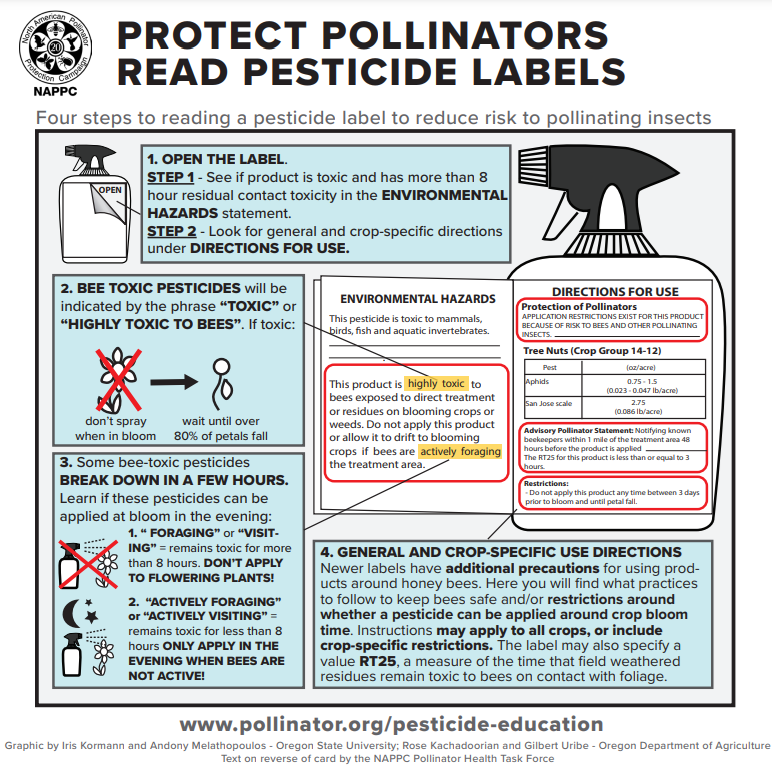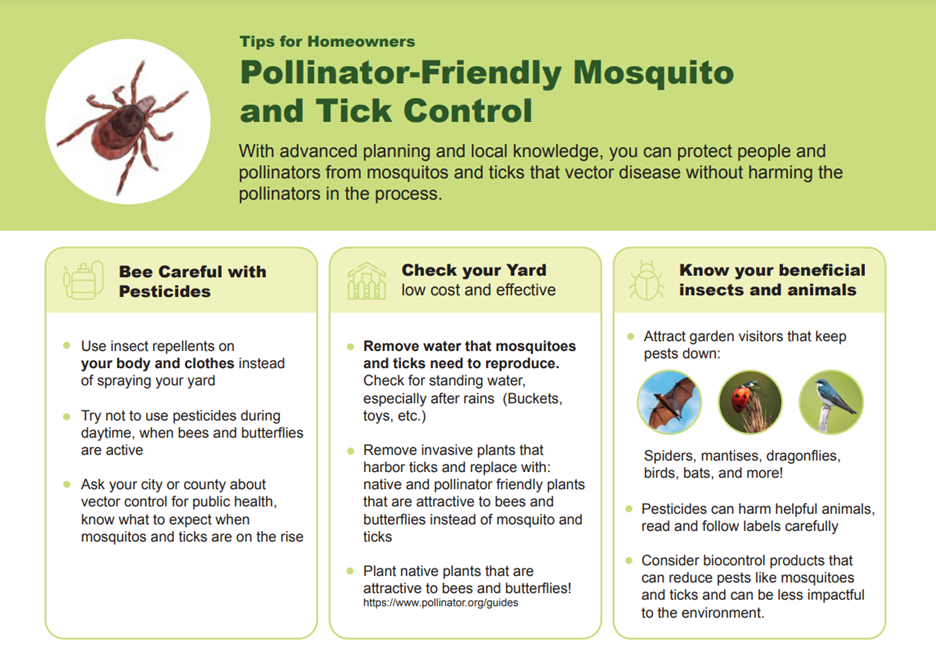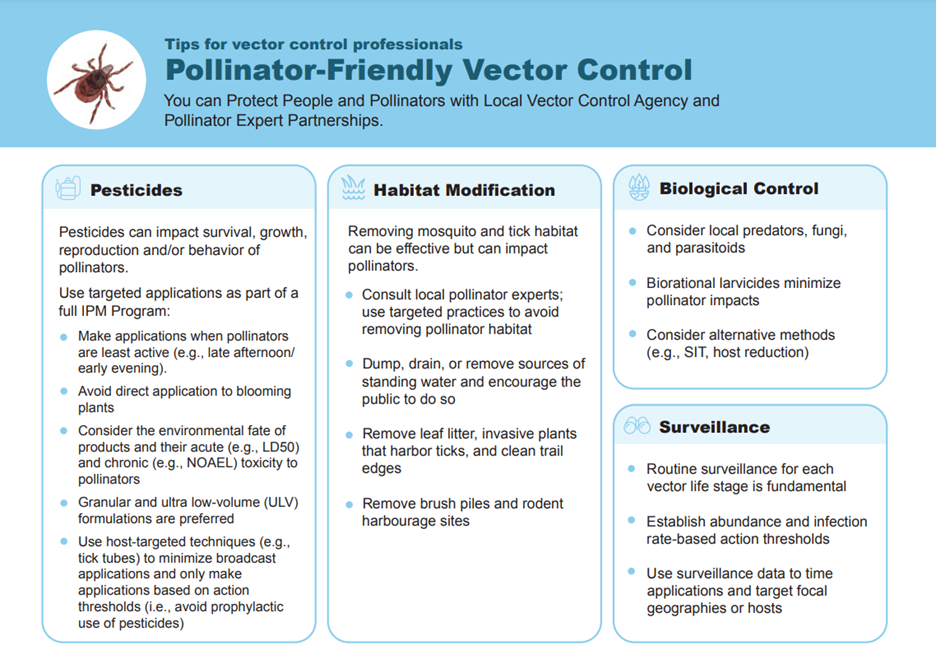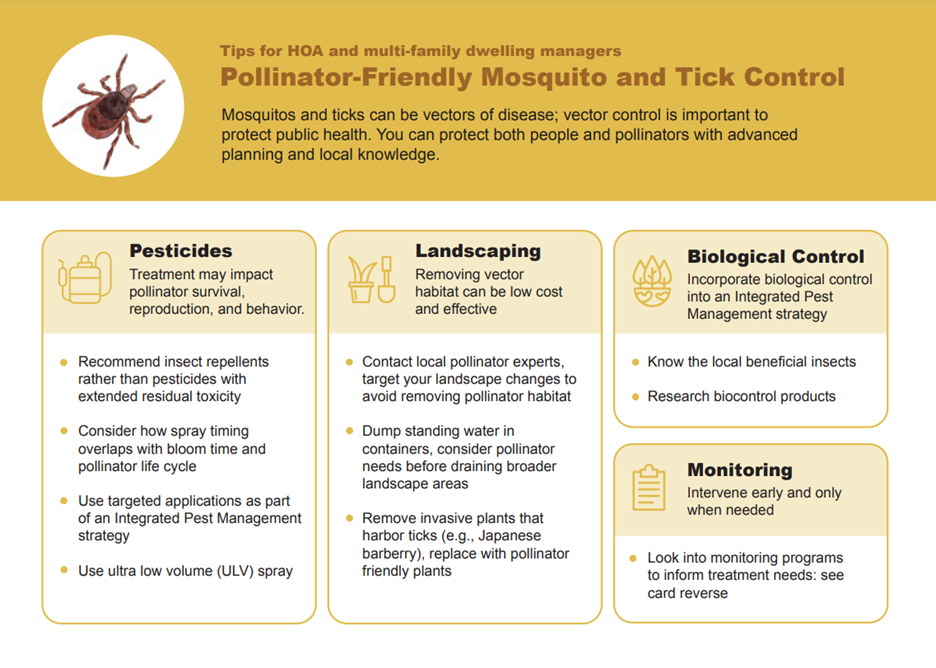Pesticide Education Task Force
Revise and develop and disseminate pesticide applicator training throughout the US and address other pressing pesticide issues. Increase interests in label clarification and simplification. Download the NAPPC Pesticide Education Task Force 2021/2022 update by clicking on the button below.
Reading Pesticide Labels
All pesticide labels in the U.S. have information on the hazards they pose to bees and what steps applicators should take to reduce exposure. This card covers all the key bee safety messages you will encounter on a pesticide label and includes additional steps (on the rear of the card) to protect bees. The card is an ideal accompaniment for continuing education programs for certified pesticide applicators.
Download InfographicEn Español
NAPPC Vector Control Cards
The following cards were developed by the NAPPC Pesticide Education Task Force and are intended to reduce non-target impacts on pollinators that can happen as a consequence of efforts to control pest species such as ticks and mosquitos. Feel free to post these cards online or distribute printed versions of them to the relevant audiences - mosquito control districts and professionals, multi-family and large housing managers, and homeowners. Send comments to info@nappc.org.
Download
Download
How to Help Pollinators Thrive in Your Garden
Everyone can contribute to promoting pollinator health and wellbeing in their community. One way is by creating an inviting habitat with abundant floral resources (pollen and nectar) so that pollinators can meet their nutritional needs and thrive.
You can help ensure bees and other pollinators have access to such resources by contributing to:
Habitat
Pollinators need sustainable places to live, nutritious food to eat and clean water to drink. While land use and development can impact pollinator habitat options, you can provide support by:
- Leaving areas in the garden bare for ground-nesting, solitary species. Leaving hollow logs can also provide nesting habitat for cavity nesting bees.
- Providing a bee hotel or nesting box to serve as homes for solitary bees, such as mason bees or leafcutter bees. Bee hotels with replacement paper or reed tubes are available readymade or are also an easy do-it-yourself (DIY) project. These disposable tubes are important to keep nesting cavities free of fungal diseases and parasites.
- Providing a water source. Adding a bird bath or water feeder with a wet surface made of sand, soil or brick to your yard will allow pollinators to safely collect water without drowning. Providing wet soil, particularly loam or clay, helps some species of bees that collect mud to seal their nests.
- Adding or increasing flower bed areas. You might be surprised to learn which plants pollinators love to visit. Preferred blooms may be those of native plants with smaller and less showy flowers. For more information about which plants are best suited to pollinators in your area, visit websites available from your state’s land-grant university extension office, non-profit organizations, state department of natural resources, or federal agencies. A general rule of thumb is to include native plants, or introduced but non-invasive species, with blue, yellow, or bright white flowers for optimal attraction, along with plants recommended by expert sources. Some good choices also include high pollen or nectar producing trees, fruit-bearing trees, hedgerows, and flowering shrubs. Bees will be more attracted to your garden if there are a variety of plants with different bloom shapes and sizes, particularly if such plants bloom in sequence to provide food throughout the growing season. Clustering flowers of one species can also help pollinators see flowering plants from far away.
Nutrition
Pollinators need nutritious food to survive and thrive. A balanced bee diet includes nectar (sugars/carbohydrates) and pollen (protein and fat) from a diverse array of plants. Some bee species have different nutritional needs than others, so it is important to provide different types of plants for bees to visit. It is also essential to provide a variety of plants that bloom across seasons to provide a continuous food source.
Many pollinators are specialists (as opposed to generalists, like honey bees), or species that only forage on a single plant family. For this reason, it is best to check with your land-grant university’s extension office, experts at your local retail nursery or garden center, or with a professional landscaper to learn about available plants that are good sources of pollen and nectar for specialist species unique to your area.
Plant Health
Planting gardens and containers to attract pollinators may also bring unwanted pests that can harm flowering plants and diminish resources for the pollinators you are working to attract. Pesticides may be one option you choose to control such pests, depending on the seriousness of your pest problem. Whether you are using a synthetic, natural, or organic product, always read and follow all label directions. This ensures safe use and effectiveness for target pests, and compliance with state and federal law.
When using any pesticide but particularly when using insecticides, avoid treating plants in bloom and apply products early in the morning (well before 9:00 a.m.) or in the evening when bees and other pollinators are usually not active or foraging. Pollinators will be most active when temperatures are warmer, so optimum pesticide application timing may change throughout the growing season. Lawn and garden product labels will tell you more, so be sure to read them thoroughly and follow all steps for safe and effective application. Your local university extension office will also offer more information on treating your garden for local pests.
Community
Individual efforts to attract and sustain pollinators in your yard can be scaled up to the community level. Talking with your local community leaders about establishing pollinator habitats in public spaces is one good first step to creating a pollinator-sustaining community. There are funding sources and detailed land management guides available to support these initiatives. Community-supplied bee boxes and planting of low-maintenance perennial flowering trees, hedgerows, shrubs, and perennial wildflowers are simple ways to beautify public and commercial spaces and to put out the welcome mat for pollinators.





